Change in Material Per Turn

This chart is based on a single playout, and gives a feel for the change in material over the course of a game.
Ayu (short for "attach your units") is a dynamic connection game for two players: Black and White. It is played with black and white pieces on the intersections (points) of an odd-sized square board.
In these rules, "adjacent" always means "orthogonally adjacent".
A unit is a singleton or group. A singleton is a piece with no adjacencies to like-colored pieces. A group is an entire set of like-colored, mutually adjacent pieces.
On your turn, you must either move a friendly singleton to an adjacent empty point or move a piece from a friendly group to a different empty point adjacent to the same group. All pieces which were part of the same group before the move must be part of the same group after the move.
Every move must reduce the distance between the moved unit and the closest friendly unit. The distance between two units is the shortest path of adjacent empty points between them, i.e. the number of consecutive moves you would need to join them.
If you can't make a move on your turn, you win. This occurs when there is no open path between any two of your units or, more frequently, when your pieces are all together in the same group.
If a board position is repeated with the same player to move, the game ends in a draw. This is known to be a possibility if both players cooperate, which doesn't happen in actual play.
The pie rule can be used in order to balance the game.
General comments:
Play: Combinatorial
Family: Combinatorial 2012
Components: Board
| BGG Entry | Ayu |
|---|---|
| BGG Rating | 7.59 |
| #Voters | 15 |
| SD | 2.15872 |
| BGG Weight | 3 |
| #Voters | 1 |
| Year | 2011 |
| User | Rating | Comment |
|---|---|---|
| luigi87 | 9 | My game. |
| mrraow | 8 | Awesome unification game, where your own pieces work against you. I have yet to work out a good strategy, but have found many ways to fail :) |
| Ottia | 10 | Each turn a piece/group has to move towards one of the closest pieces/groups to it; pieces move one space and a piece at one end of a group can be placed at another end. The first player unable to move wins. It's as simple as that, but varied and very, very deep. Immaculate. Supremely elegant. |
| milomilo122 | N/A | For those who follow the development of "minute to learn, lifetime to master" perfect information abstract strategy games, Luis Bolaños Mures, who went on a tear in 2011, is a name to watch. I've only played Ayu once but it's a fantastic illustration of why I like his design sensibility; it might be the best among several designs he made public in 2011. It feels intuitive from the first play. There's little confusion or "playing blind" feeling that accompanies most abstract games. The rules work so well that it doesn't even matter that they include mechanics that I normally don't like: initial "checkerboard" layouts and a "stones must get closer" rule. The sum is greater than the parts, it would seem, another hallmark of good design. |
| dave doma | 10 | |
| Kaffedrake | 6 | Ayu is an intriguing abstract game of connection and obstruction that feels as if it has both tactical and strategic elements (perhaps more of the former on small boards). It is quite possibly worthy of a following. There are a few things that I believe may present an obstacle to achieving a place among the classics, although given that I'd be loath to mess with the game's elegantly minimalistic ruleset I would perhaps refer to them as quirks rather than flaws. First, identifying legal moves involves comparing distances along any number of winding paths on the board. It's often easy enough to determine the available options of a single group, but the difficulty of measuring the "connectedness" of several groups and projecting it forward may present a barrier to global strategic reading. Of course, since controlling the available moves of your own groups as well as those of your opponent by manipulating path lengths is an important element of gameplay, arguably such reading is just a skill to be developed, but it's not at all hard to imagine that in a game between casual players someone could make an illegal move and nobody would notice. Second, the sudden death resulting from groups being entirely blocked off can lead to some unintuitive outcomes where you are seemingly punished for blocking too effectively. To be sure, some sort of safety valve is necessary, and unlike Volo Ayu doesn't need to add a rule but simply relies on the standard win condition for combinatorial games, but it can still create odd situations such as when both players are forced to race towards the same choke point and whoever gets there first loses. On the whole, though, endgames seem to be much less awkward and drawn-out than in Volo. Third, concerning the use of the pie rule as a balancing mechanism, it's not obvious to me that there exist both moves that are worth less than a "half move" and ones that are worth more, or if they do, that players can tell the difference with any reliability. I would be tempted to drop that rule, mandate boards big enough that the first-move advantage is thoroughly diluted, and tolerate what remains. |
| reyalicea | 10 | I've played this game a few times now and changed my rating to a 10, all I have to say is wow! It is poetry in motion Luis, bravo! |
| orangeblood | 7 | There is a lot to think about here, and I look forward to more plays. |
| simpledeep | 8 | |
| clayhaus | 8 | Played once solo, to get the mechanics down and see a lot of nuance in this game. It may start a bit slow with singletons attaching, but that is likely deceptive as the jockeying leads to a fair amount tactical maneuvering. Look forward to more plays. Against real opponents! |
| fogus | 6.25 | |
| CDRodeffer | 7 | A game about manipulating the tempo to be able to connect all your pieces into a single group. I like it better than most games of tempo. |
| deleted | 7 | Excellent game, but the rules are way too concise for its own good. More examples in the published rules-pdf would be very useful. |
| russ | 8 | Quite cool fun game which has a bit of a Quoridor vibe (but your blocking walls can [i]shift[/i] to some extent, with interesting restrictions on how). The interestingly restricted movement rule (you can't split groups and you must make the moving unit be a space closer to one of its closest neighbors) works out interestingly well. And somewhat unexpected "win if you can't move" rule (instead of simply "win if you unite all your stones into one group") means that you must be careful not to isolate your opponent's remaining groups into separate disconnected regions, even though temporarily isolating them can be useful. That's cool. |
| fuchsundbrunnen | 8.6 | |
| Smjj | 1 |
| AI | Strong Wins | Draws | Strong Losses | #Games | Strong Win% | p1 Win% | Game Length |
|---|---|---|---|---|---|---|---|
| Random | |||||||
| Grand Unified UCT(U1-T,rSel=s, secs=0.01) | 36 | 0 | 0 | 36 | 100.00 | 47.22 | 45.42 |
| Grand Unified UCT(U1-T,rSel=s, secs=0.20) | 36 | 0 | 5 | 41 | 87.80 | 58.54 | 46.15 |
| Grand Unified UCT(U1-T,rSel=s, secs=1.48) | 36 | 0 | 5 | 41 | 87.80 | 46.34 | 48.51 |
Level of Play: Strong beats Weak 60% of the time (lower bound with 90% confidence).
Draw%, p1 win% and game length may give some indication of trends as AI strength increases; but be aware that the AI can introduce bias due to horizon effects, poor heuristics, etc.
| Size (bytes) | 30784 |
|---|---|
| Reference Size | 10577 |
| Ratio | 2.91 |
Ai Ai calculates the size of the implementation, and compares it to the Ai Ai implementation of the simplest possible game (which just fills the board). Note that this estimate may include some graphics and heuristics code as well as the game logic. See the wikipedia entry for more details.
| Playouts per second | 8020.84 (124.68µs/playout) |
|---|---|
| Reference Size | 585034.81 (1.71µs/playout) |
| Ratio (low is good) | 72.94 |
Tavener complexity: the heat generated by playing every possible instance of a game with a perfectly efficient programme. Since this is not possible to calculate, Ai Ai calculates the number of random playouts per second and compares it to the fastest non-trivial Ai Ai game (Connect 4). This ratio gives a practical indication of how complex the game is. Combine this with the computational state space, and you can get an idea of how strong the default (MCTS-based) AI will be.
| 1: Player 1 (Black) win % | 56.65±0.78 | Includes draws = 50% |
|---|---|---|
| 2: Player 2 (White) win % | 43.35±0.78 | Includes draws = 50% |
| Draw % | 0.00 | Percentage of games where all players draw. |
| Decisive % | 100.00 | Percentage of games with a single winner. |
| Samples | 15515 | Quantity of logged games played |
Note: that win/loss statistics may vary depending on thinking time (horizon effect, etc.), bad heuristics, bugs, and other factors, so should be taken with a pinch of salt. (Given perfect play, any game of pure skill will always end in the same result.)
Note: Ai Ai differentiates between states where all players draw or win or lose; this is mostly to support cooperative games.
Rotation (Half turn) lost each game as expected.
Reflection (X axis) lost each game as expected.
Reflection (Y axis) lost each game as expected.
Copy last move lost each game as expected.
Mirroring strategies attempt to copy the previous move. On first move, they will attempt to play in the centre. If neither of these are possible, they will pick a random move. Each entry represents a different form of copying; direct copy, reflection in either the X or Y axis, half-turn rotation.
| Game length | 41.30 | |
|---|---|---|
| Branching factor | 25.90 | |
| Complexity | 10^52.99 | Based on game length and branching factor |
| Computational Complexity | 10^6.99 | Saturation reached - accuracy very high. |
| Samples | 15515 | Quantity of logged games played |
| Distinct actions | 6321 | Number of distinct moves (e.g. "e4") regardless of position in game tree |
|---|---|---|
| Killer moves | 75 | A 'killer' move is selected by the AI more than 50% of the time Killers: i3-b9,e6-i9,i3-a9,h1-a8,c2-i1,a9-e2,a9-d6,a9-c2,a9-c8,a9-i3,a9-g4,e1-i8,a4-i9,e1-a8,e1-a9,a4-h9,a4-h8,a4-f1,i9-i2,i9-g6,i9-f2,i9-e3,i9-e6,i9-d9,i9-c5,i9-c2,i9-c9,i9-b4,i9-b8,i8-d9,d9-a2,d9-a1,i3-d1,g9-i1,i2-c9,i2-d9,g9-a3,c1-b9,b9-a2,b9-a1,i1-f1,i1-d9,i1-d2,b9-i2,a7-h1,i7-e1,i7-c1,a2-h1,i6-b2,i6-a1,e9-i1,e9-a2,a1-c6,a1-b5,a1-h6,a1-f2,a6-h2,h9-i3,h9-a4,d1-i9,d1-i6,a5-i3,a5-f9,c9-a2,a5-e1,e2-i1,i5-a1,i5-a2,i5-a3,i4-b8,b1-i9,b1-i2,b1-h9,f9-a4,b1-a7 |
| Good moves | 5993 | A good move is selected by the AI more than the average |
| Bad moves | 327 | A bad move is selected by the AI less than the average |
| Terrible moves | 152 | A terrible move is never selected by the AI Terrible moves: a9-a5,h1-b9,i3-a8,h1-a2,h1-a7,a9-e9,a9-d2,a9-d8,a9-d7,a9-c3,a9-c6,a9-b5,a9-i5,a9-h5,a9-h7,a9-f1,a9-f8,a9-f7,i9-a3,i9-a6,i9-a5,i9-a9,i9-i1,i9-h2,i9-h5,i9-h6,i9-h3,i9-h7,i9-g3,i9-g8,i9-f4,i9-f1,i9-f7,i9-f8,i9-e2,i9-e5,i9-d1,i9-d5,i9-d3,i9-d7,i9-c4,i9-c3,i9-b7,i9-b5,i9-b6,i8-a8,i8-a9,d9-i2,h1-i7,b5-a9,a2-e9,c1-a8,g9-h1,g9-i2,i2-a9,i2-a2,i2-a1,a8-i2,a8-h2,a8-h9,g9-a4,g9-a1,a8-g1,a8-f1,c1-h9,c1-i8,a8-e1,b9-a3,a7-g1,a7-g3,i1-h8,i1-h4,i1-i6,i1-i7,i1-f7,i1-f8,i1-f5,i1-g7,i1-g4,i1-e6,i1-e7,i1-e2,i1-e1,i1-b5,i1-b6,i1-b4,i1-b2,i1-c6,i1-c5,b9-i4,b9-i3,b9-i1,i1-a4,i1-a2,g8-a9,a7-i8,e4-a1,h5-i1,i7-d5,i7-a9,a2-i1,a2-g9,a2-g6,g2-i1,i6-b5,e9-i2,e9-h1,a1-e5,a1-e7,a1-d4,a1-d5,a1-d2,a1-c2,a1-b4,a1-b3,a1-b6,a1-b8,a1-b7,a1-i9,a1-i8,a1-i5,a1-i7,a1-i1,a1-i3,a1-g7,a1-f6,a1-f5,a1-f8,a1-f7,a1-a6,g1-a8,a6-i8,d1-a8,h9-i4,h9-c1,d1-i8,a5-i9,a5-i1,c9-h1,c9-i1,c9-a1,e8-i9,i5-d1,g1-i8,g1-i9,g1-i6,i5-b9,i4-a9,b1-i4,f9-a2,b1-c9,b1-b9 |
| Samples | 15515 | Quantity of logged games played |

This chart is based on a single playout, and gives a feel for the change in material over the course of a game.

This chart shows the best move value with respect to the active player; the orange line represents the value of doing nothing (null move).
The first player held the advantage throughout the game. The lead changed on 0% of the game turns. Ai Ai found 1 critical turn (turns with only one good option).
Overall, this playout was 51.02% hot.

This chart shows the relative temperature of all moves each turn. Colour range: black (worst), red, orange(even), yellow, white(best).

Table: branching factor per turn.

This chart is based on a single playout, and gives a feel for the types of moves available over the course of a game.
Red: removal, Black: move, Blue: Add, Grey: pass, Purple: swap sides, Brown: other.
| 0 | 1 | 2 | 3 | 4 |
|---|---|---|---|---|
| 1 | 62 | 3806 | 109054 | 3002010 |
Note: most games do not take board rotation and reflection into consideration.
Multi-part turns could be treated as the same or different depth depending on the implementation.
Counts to depth N include all moves reachable at lower depths.
Inaccuracies may also exist due to hash collisions, but Ai Ai uses 64-bit hashes so these will be a very small fraction of a percentage point.
No solutions found to depth 4.
| Moves | Animation |
|---|---|
| b1-c1,g4-f4,b7-c7,f4-e5,c1-d2,i2-i3,d1-c3,e2-f2,h3-h2,e4-e7 | 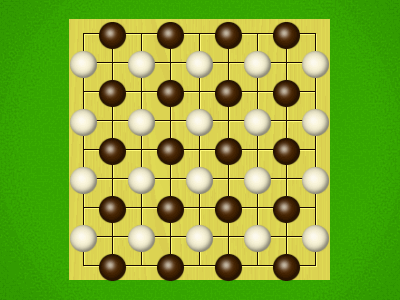 |
| b1-b2,a2-a3,b2-c3,c2-d2,b9-b8,a3-b4,b3-d4,a4-c5,b5-b6,b4-d6 | 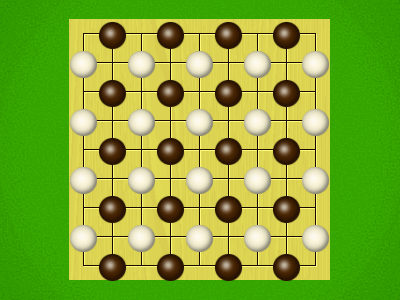 |
| b1-b2,a2-a3,b2-b4,a3-a5,d1-d2,c2-c3,b3-b6,c3-c5,d2-e3,g2-g3 | 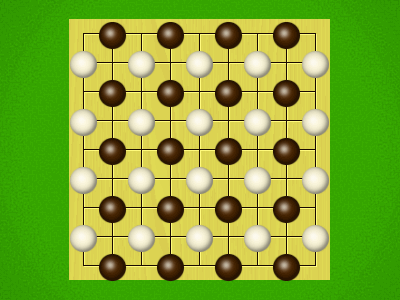 |
| b1-b2,a2-a3,b2-b4,a3-a5,h9-g9,g2-g3,g9-e9,i2-i3,f9-d8,i3-h4 | 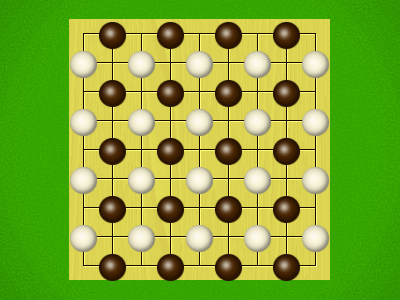 |
| b1-b2,a2-a3,f1-f2,g2-h2,d1-d2,a3-b4,b2-c3,e2-e3,b3-d4,e3-f4 | 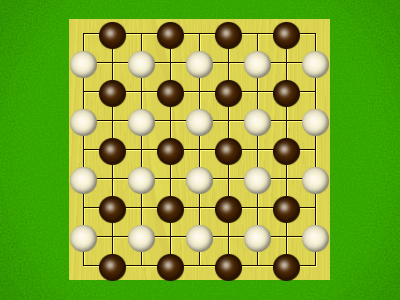 |
| b1-b2,a2-a3,f1-f2,g2-h2,d1-d2,e2-e3,b2-c3,a3-b4,b3-d4,e3-f4 | 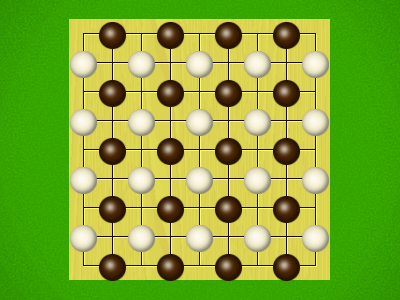 |
| b1-b2,a2-a3,f1-f2,g2-h2,d1-d2,e2-e3,b2-c3,i4-i5,b9-c9,e3-e5 | 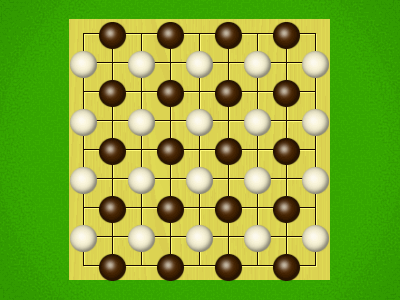 |
| b1-b2,a2-a3,f1-f2,g2-h2,d1-d2,g8-g7,b2-b4,e2-e3,h1-g1,c2-c3 | 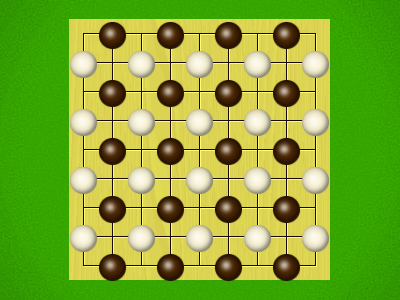 |
| b1-b2,c2-c3,d1-d2,i2-h2,b2-b4,i4-h4,d2-e3,e2-f2,d3-f4,c3-c5 | 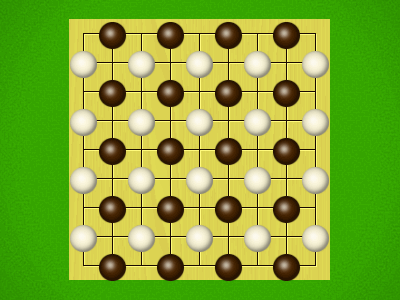 |
| b1-b2,c2-c3,d1-d2,i2-h2,b2-b4,a8-b8,f1-f2,e2-e3,h9-h8,c3-c5 |  |
| b1-b2,c2-c3,d1-d2,i2-h2,f1-f2,e2-e3,b2-b4,a8-b8,h9-h8,c3-c5 | 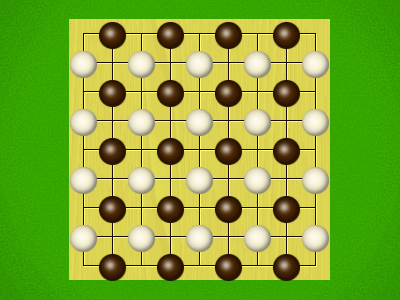 |
| b1-b2,c2-c3,d1-d2,i2-h2,f1-f2,a8-b8,b2-b4,e2-e3,h9-h8,c3-c5 | 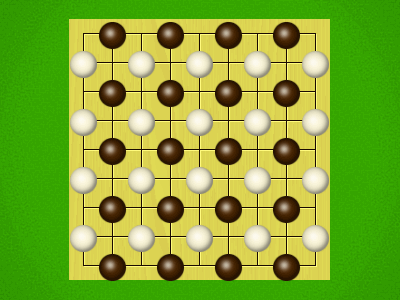 |
| Puzzle | Solution |
|---|---|
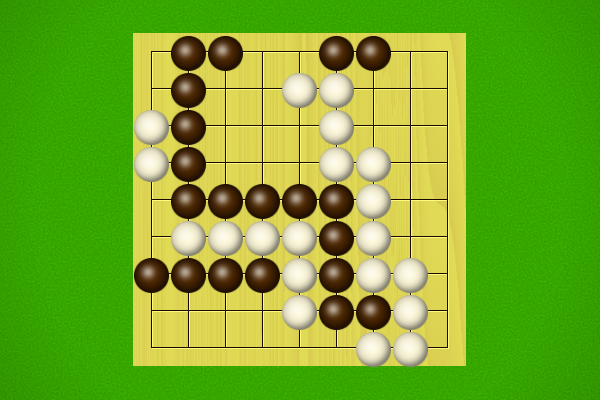 Player 1 (Black) to win in 17 moves | |
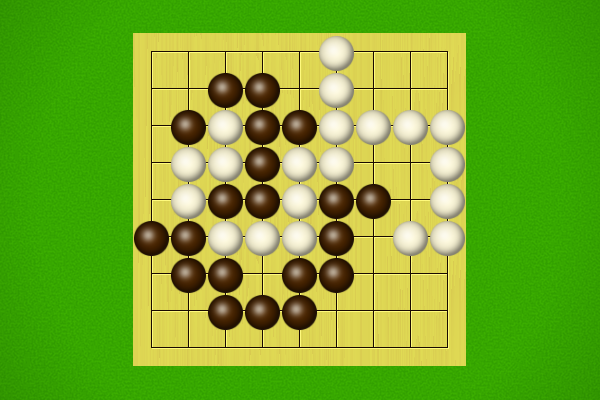 Player 2 (White) to win in 11 moves | |
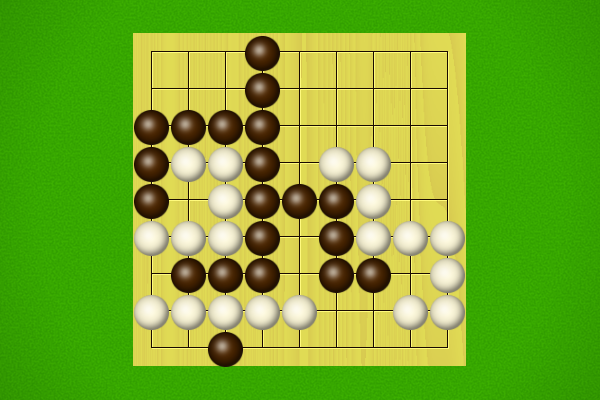 Player 1 (Black) to win in 9 moves | |
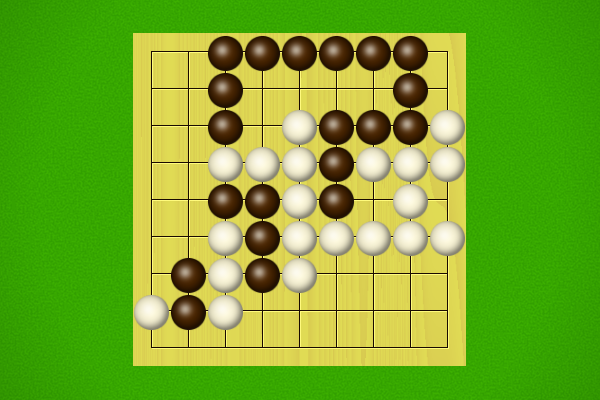 Player 1 (Black) to win in 9 moves | |
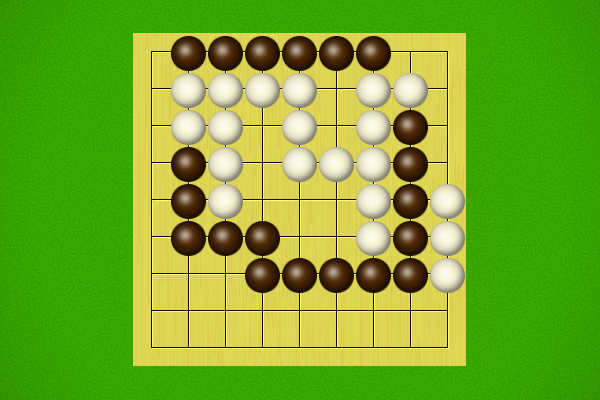 Player 1 (Black) to win in 9 moves | |
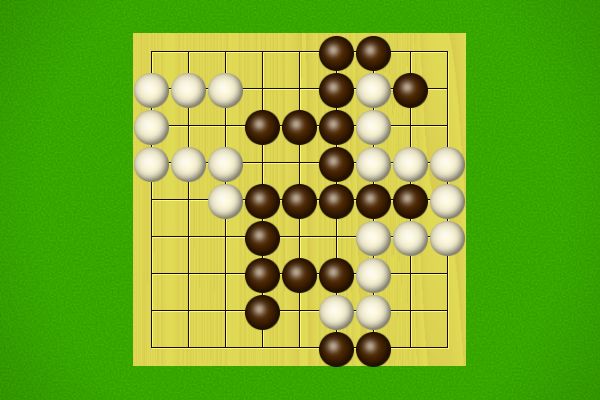 Player 2 (White) to win in 9 moves | |
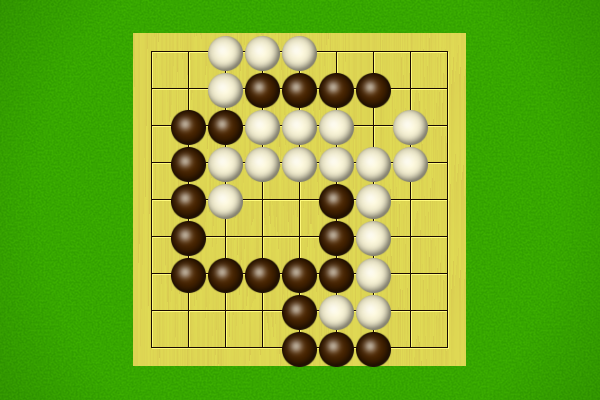 Player 1 (Black) to win in 7 moves | |
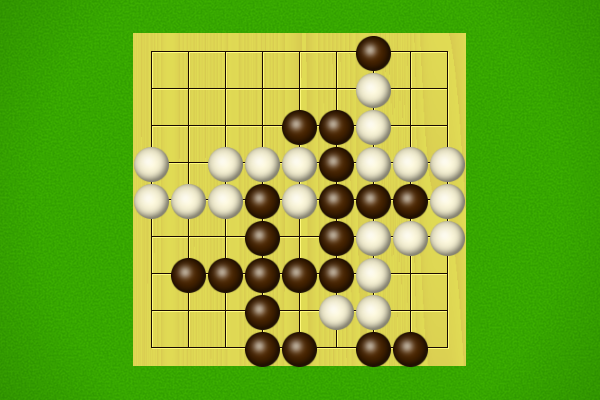 Player 2 (White) to win in 9 moves | |
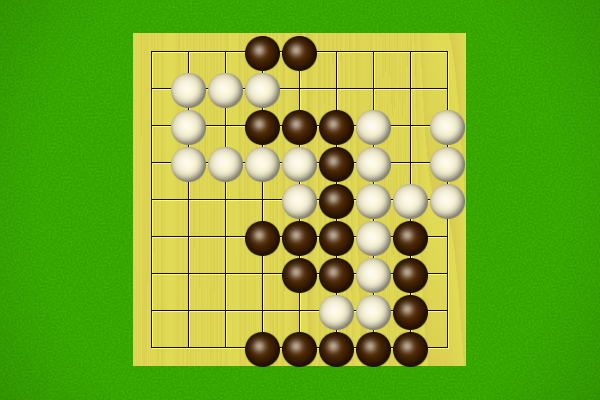 Player 2 (White) to win in 7 moves | |
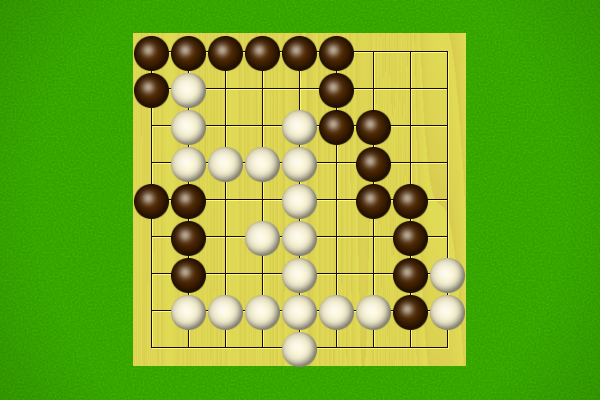 Player 1 (Black) to win in 5 moves | |
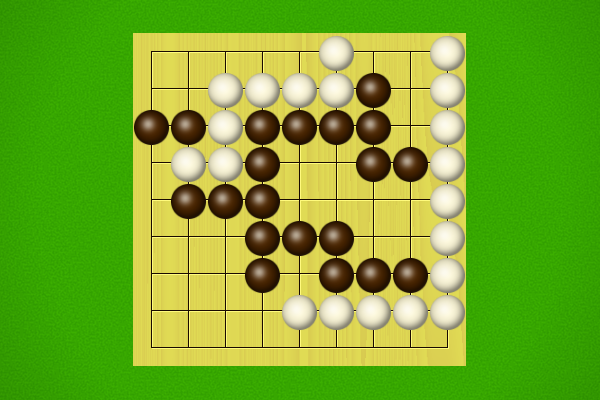 Player 2 (White) to win in 5 moves |
Selection criteria: first move must be unique, and not forced to avoid losing. Beyond that, Puzzles will be rated by the product of [total move]/[best moves] at each step, and the best puzzles selected.